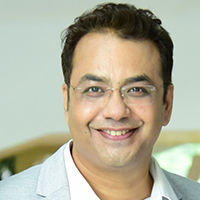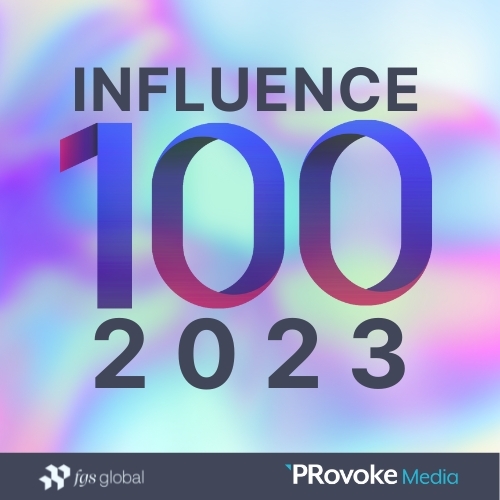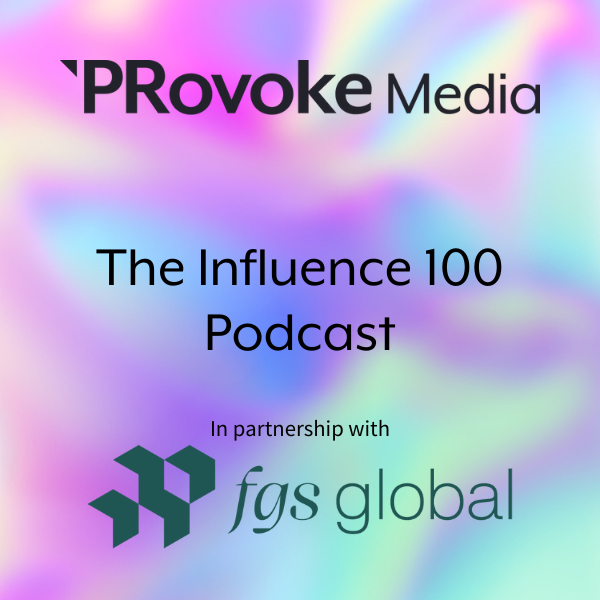
 Podcasts
PodcastsCatch the latest PR news & updates with PRovoke Media's PR Podcasts. Lifting the lid on key industry stories & trends, join our listeners of PR podcasts today.
 Videos
VideosLatest video interviews and campaigns from PRovoke Media, previously known as the Holmes Report.
Long-form journalism that analyzes the issues, challenges and opportunities facing the business and practice of PR.
 Profiles & Interviews
Profiles & InterviewsExplore PR profiles and interviews with leaders from the marketing and PR worlds.
 Crisis Review
Crisis ReviewPR Crisis & Business Crisis review. PRovoke Media's annual analysis of the top reputation crises to rock the corporate sector. Read on here.
 Coronavirus
CoronavirusPRovoke Media's coverage of the Covid-19 crisis, focusing on corporate communication, public affairs & PR industry fallout.
 Trend Forecasts
Trend ForecastsPRovoke Media's PR Trends round up. PRovoke Media's annual forecast of PR trends and news that will impact the PR world in the year ahead...
 Social & Digital
Social & DigitalDedicated to exploring the new frontiers of PR as it dives deeper into social media, content and analytics.
 Technology
TechnologyOur coverage of key technology PR trends and challenges from around the world of digital communications.
 Consumer
ConsumerFrom brand marketing to conscious consumerism, coverage of key marketing and PR trends worldwide.
 Employee Engagement
Employee EngagementPRovoke Media's coverage, analysis and news around the rapidly-shifting area of employee engagement and internal communications.
 Sports Marketing
Sports Marketing Sports PR news, diversity & inclusion trends, views and analysis from PRovoke Media. Subscribe today for the very latest in the world of sports communications.
 Global PR Agency Rankings
Global PR Agency RankingsPRovoke Media's definitive global benchmark of global PR agency size and growth.
Enter PRovoke Media's 2024 Global 250 Agency Ranking and/or our Agencies of the Year competitions now.
 Agencies of the Year
Agencies of the YearPRovoke Media's annual selections for PR Agencies of the Year, across all of the world's major markets.
 Innovator 25
Innovator 25PRovoke Media profiles marcomms innovators from across North America, EMEA and Asia-Pac.
 Creativity in PR
Creativity in PRIn-depth annual research into the PR industry's efforts to raise creative standards.
 Asia-Pacific Communication Index
Asia-Pacific Communication IndexAPACD/Ruder Finn annual study of Asia-Pacific in-house communications professionals.
 SABRE Awards
SABRE AwardsThe world's biggest PR awards programme, dedicated to benchmarking the best PR work from across the globe.
 PRovokeSummit Global
PRovokeSummit GlobalThe biggest PR conference of the year, a high-level forum designed to address the critical issues that matter most.
 PRovoke Media Regional Series
PRovoke Media Regional SeriesA global network of conferences that explore the innovation and disruption that is redefining public relations.
 Agencies of the Year
Agencies of the YearUnrivalled insight into the world's best PR agencies, across specialist and geographic categories.
 Roundtables
RoundtablesOur Roundtables bring together in-house comms leaders with PR firms to examine the future of communications.
 Agency Playbook
Agency PlaybookThe PR industry’s most comprehensive listing of firms from every region and specialty
.jpg) All Jobs
All JobsFind the latest global PR and communications jobs from PRovoke Media. From internships to account executives or directors. See all our PR jobs here.
PRovoke Media's editorial series published in collaboration with partners.

Sujit Patil has overseen a stellar communications evolution at Godrej Industries Limited and Associate companies - one of India’s most diversified and trusted conglomerates. He and his team have one of the most comprehensive PR, reputation building and brand communications mandates in the country. All told, Patil and his team manage a wide portfolio of businesses ranging from FMCG, real estate, agriculture, animal feed, chemicals, food, oils, financial services, amongst others.
The operational scope spans across PR, digital PR, influencer engagement, managing key opinion leaders, building communities, government body relations, academic interventions, research-driven narratives, experiential owned media platforms, measurement and analytics, ORM & crisis management. His philosophy of POEMS (Paid, owned, earned media strategies) for integrated communications has been institutionalized to tell the Godrej story to over 750 million consumers in India, and close to 1.2 billion across the world.
Those efforts have not escaped the attention of Patil’s peers, with Godrej winning the Diamond SABRE Award for excellence in reputation management in both South Asia and Asia- Pacific, along with Company of the Year at the former show.
Can you share a moment in your career when you saw PR’s direct impact on business performance?
There have been many wow moments of PR creating delight for businesses. I see it all the time. Campaigns that have a good integration of POEMS – paid, owned, earned media strategies – have been the most impactful for us. An example of a recent effective brand PR campaign would be the launch of a ‘GoodKnight’ mini, a smaller and lower-cost liquid vaporizer mosquito repellent format. The objective was to make it affordable for masses, bring back the narrative of being serious about mosquito-borne diseases, focus on which had gone down during Covid and also address the effects of the burgeoning menace of illegal incense sticks being used to kill mosquitoes. The integrated PR plan incorporated research data, key opinion leaders, doctors and government officials to sensitize media and hence the public on the need to use appropriate repellent formats. Due to effective integration of traditional and digital PR tools, the campaign exceeded the overall objectives of the campaign.
What are the communications industry’s biggest challenges and opportunities in the year ahead?
With dwindling attention spans, the advent of technologies like generative AI, the explosion of data, the prevalence of fake news, weak macro indicators, the inherent need to be pompous in brand communications and increased attention towards authentic hyperlocal content, communicators’ challenges and opportunities are at an all-time high. In India, the diversity of languages adds to the complexity. However, with technology and the new pandemic-led insight to be more empathetic and inclusive, communicators are adapting themselves towards crisper formats that are snackable, believable and authentic. Generative AI, while it is seen as a challenge and a potential replacement of jobs, has immense potential to modernize the PR profession. From improved customer engagement to enhanced content creation, it can streamline PR processes and help professionals free up time to achieve their goals more effectively by focusing on more strategic PR interventions.
What have you most admired about the communications industry over the past year, and what has disappointed you?
The resilience, and the ability to rise up and stay relevant is something I admire. However, not much has been done in the space of diversity and inclusion. I feel the pandemic took the situation back by a couple of years. Capability building in agencies to service clients in the new circumstances – enhancing tech, data and measurement skills – could have been better.
What work from your team are you most proud of over the past year?
We realized the need to have data and insights-driven PR and launched an in-house vertical for research driven narratives. Today, almost all our campaigns are based on research, use digital and experiential owned media platforms, engage KOLs and influencers and have an element of measurement driven by return on objectives. This has raised the bar of outcomes and impact and helped garner us high internal NPS scores, as well as industry peer recognition.
How have you switched off from work and maintained wellness over the past year?
I am a weekend farmer. Nature in its full glory gives me a high. Given an opportunity I drive down to my farm in Karjat, Maharashtra, about 100km from Mumbai and spend time with my green friends and some fresh oxygen. Working on the farm or just sitting and reflecting under the shade of a mango tree with a mug of chilled liquid that comes in amber-colored bottles or cans is the best way to unwind.
Which book/movie/TV show/podcast/playlist/other cultural source has helped you get through the past year or provided inspiration?
Suits has been my favourite series and my favourite book is ‘Shivaji’ The great Maratha by Ranjit Desai. I would recommend it highly. It is a book that teaches you strategy, organisation building, patriotism, humility, leadership, intelligence, and many other evergreen life facets through the story of Chhatrapati Shivaji Maharaj, the great Maratha King. I can also never get enough of reading Jonathan Livingston Seagull, written by American author Richard Bach. The profound message it gives us is that we can all be much more than we believe or are given to believe.
If I wasn't working in marketing/communications, I would be...
I started my career as a sales engineer selling high-end instrumentation products and services to chemical, pharmaceutical, petroleum and other process plants. Had the job rotation to the communications function (where I fell in love with marketing, communications and PR) not happened, I would have been a sales professional today.




Intelligence and insight from across the PR world.
About PRovoke Media Contact Us Privacy & Cookie PolicyWe feel that the views of the reader are as important as the views of the writer. Please contact us at [email protected]
Signup For Our Newsletter Media Kits/Editorial Calendar Jobs Postings A-Z News Sitemap© Holmes Report LLC 2024